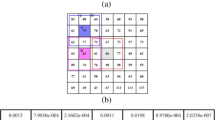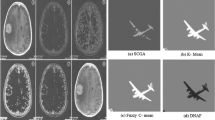Abstract
Fuzzy c-means (FCM) algorithms have been shown effective for image segmentation. A series of enhanced FCM algorithms incorporating spatial information have been developed for reducing the effect of noises. This paper presents a robust FCM algorithm with non-local spatial information for image segmentation, termed as NLFCM. It incorporates two factors: one is the local similarity measure depending on the differences between the central pixel and its neighboring pixels in the image; the other is the non-local similarity measure depended on all pixels whose neighborhood configurations are similar to their neighborhood pixels. Furthermore, an adaptive weight is introduced to control the trade-off between local similarity measure and non-local similarity measure. The experimental results on synthetic images and real images under different types of noises show that the new algorithm is effective, and they are relatively independent to the types of noises.











Similar content being viewed by others
References
Cai W, Chen S, Zhang D (2007) Fast and robust fuzzy c-means clustering algorithms incorporating local information for image segmentation. Pattern Recogn 40:8–838
Zhou H, Schaefer G, Sadka A, Celebi ME (2009) Anisotropic mean shift based fuzzy c-means segmentation of dermoscopy images. IEEE J Sel Top Signal Process 3:26–34
Jiao L, Gong M, Wang S et al (2010) Natural and remote sensing image segmentation using memetic computing. IEEE Comput Intell Mag 5:78–91
Arbelaez P, Maire M, Fowlkes C, Malik J (2011) Contour detection and hierarchical image segmentation. IEEE Trans Pattern Analysis Mach Intell 33:898–916
Yeung D, Wang X (2002) Improving performance of similarity-based clustering by feature weight learning, IEEE Trans. Pattern Analysis Mach Intell 24:556–561
Wang X, Wang Y, Wang L (2004) Improving fuzzy c-means clustering based on feature-weight learning. Pattern Recogn Lett 25:1123–1132
Kim J, Cai W, Eberl S, Feng D (2007) Real-time volume rendering visualization of dual-modality PET/CT images with interactive fuzzy thresholding segmentation. IEEE Trans Inf Technol Biomedicine 11:161–169
Siang Tan K, Isa NAM (2011) Color image segmentation using histogram thresholding–fuzzy c-means hybrid approach. Pattern Recogn 44:1–15
Malladi R, Sethian J, Vemuri B (1995) Shape modeling with front propagation: a level set approach, IEEE Trans. Pattern Analysis Mach Intell 27:793–800
Zhang K, Zhang L, Song H, Zhang D (2012) Re-initialization free level set evolution via reaction diffusion. IEEE Trans Image Process 21 http://arxiv.org/abs/1112.1496
Adams R, Bischof L (1994) Seeded region growing, IEEE Trans. Pattern Analysis Mach Intell 16:641–647
Cardinale J, Paul G, Sbalzarini IF (2012) Discrete region competition for unknown numbers of connected regions. IEEE Trans Image Process 21:3531–3545
Bezdek JC (1981) Pattern recognition with fuzzy objective function algorithms. Plenum, New York
Ji ZX, Sun QS, Xia DS (2011) A framework with modified fast FCM for brain MR images segmentation. Pattern Recogn 44:999–1013
Hung CC, Kulkarni S, Kuo BC (2011) A new weighted fuzzy c-means clustering algorithm for remotely sensed image classification. IEEE J Sel Top Signal Process 5:543–553
Chen L, Chen CLP, Lu M (2011) A multiple-kernel fuzzy c-means algorithm for image segmentation. IEEE Trans Syst Man Cybern Part B 41:1263–1274
Ahmed MN, Yamany SM, Mohamed N, Farag AA, Moriarty T (2002) A modified fuzzy c-means algorithm for bias field estimation and segmentation of MRI data. IEEE Trans Med Imaging 21:193–199
Chen SC, Zhang DQ (2004) Robust image segmentation using FCM with spatial constraints based on new kernel-induced distance measure. IEEE Trans Syst Man Cybern Part B 34:1907–1916
Szilágyi L, Benyó Z, Szilágyii SM, Adam HS (2003) MR brain image segmentation using an enhanced fuzzy c-means algorithm. In: 25th Annual International Conference of IEEE EMBS pp 17–21
Krinidis S, Chatzis V (2010) A robust fuzzy local information c-means clustering algorithm. IEEE Trans Image Process 19:1328–1337
Liu N, Chen F, Lu M (2013) Spectral co-clustering documents and words using fuzzy K-harmonic means. Int J Mach Learn Cybernet 4:75–83. doi:10.1007/s13042-012-0077-9
Ma W, Jiao L, Gong M, Li C (2013) Image change detection based on an improved rough fuzzy c-means clustering algorithm. Int J Mach Learn Cybernet. doi:10.1007/s13042-013-0174-4
Gong M, Su L, Jia M, Chen W (2013) Fuzzy clustering with modified MRF energy function for change detection in synthetic aperture radar images. IEEE Trans Fuzzy Syst. doi:10.1109/TFUZZ.2013.2249072
Gong M, Liang Y, Shi J, Ma W, Ma J (2013) Fuzzy c-means clustering with local information and kernel metric for image segmentation. IEEE Trans Image Process 22:573–584
Gong M, Zhou Z, Ma J (2012) Change detection in synthetic aperture radar images based on image fusion and fuzzy clustering. IEEE Trans Image Process 21:2141–2151
Buades A, Coll B, Morel JM (2005) A non-local algorithm for image denoising. In: Proceedings IEEE International Conference Computer Vision and Pattern Recognition, pp 60–65
Mignotte M (2008) A non-local regularization strategy for image deconvolution. Pattern Recogn Lett 29:2206–2212
Coupe P, Yger P, Prima S, Hellier P, Kervrann C, Barillot C (2008) An optimized blockwise nonlocal means denoising filter for 3-D magnetic resonance images. IEEE Trans Medical Imaging 27:425–441
Moghaddam RF, Cheriet M (2011) Beyond pixels and regions: a non-local patch means (NLPM) method for content-level restoration, enhancement, and reconstruction of degraded document images. Pattern Recogn 44:363–374
Vignesh R, Oh BT, Kou CJ (2010) Fast non-local means (NLM) computation with probabilistic early termination. IEEE Signal Process Lett 17:277–280
Feng J, Jiao LC, Zhang X, Gong M, Sun T (2013) Robust non-local fuzzy c-means algorithm with edge preservation for SAR image segmentation. Signal Process 93:487–499
Xie XL, Beni GA (1991) Validity measure for fuzzy clustering, IEEE Trans. Pattern Analysis Mach Intell 13:841–846
Bezdek JC (1973) Cluster validity with fuzzy sets. Cybern Syst 3:58–73
Bezdek JC (1975) Mathematical models for systematic and taxonomy. In: Proceedings of the eighth international conference on numerical taxonomy, pp 143–166
Zhang D, Guo Q, Wu G, Shen D (2012) Sparse patch-based label fusion for multi-atlas segmentation. Multimodal Brain Image Analysis 7509:94–102
Acknowledgments
The authors wish to thank the editors and anonymous reviewers for their valuable comments and helpful suggestions which greatly improved the paper’s quality. This work was supported by the National Natural Science Foundation of China (Grant Nos. 61273317, 61202176, 61203303), the National Top Youth Talents Program of China, the Specialized Research Fund for the Doctoral Program of Higher Education (Grant No. 20130203110011), and the Fundamental Research Fund for the Central Universities (Grant Nos. K50510020001 and K5051202053).
Author information
Authors and Affiliations
Corresponding author
Rights and permissions
About this article
Cite this article
Ma, J., Tian, D., Gong, M. et al. Fuzzy clustering with non-local information for image segmentation. Int. J. Mach. Learn. & Cyber. 5, 845–859 (2014). https://doi.org/10.1007/s13042-014-0227-3
Received:
Accepted:
Published:
Issue Date:
DOI: https://doi.org/10.1007/s13042-014-0227-3




